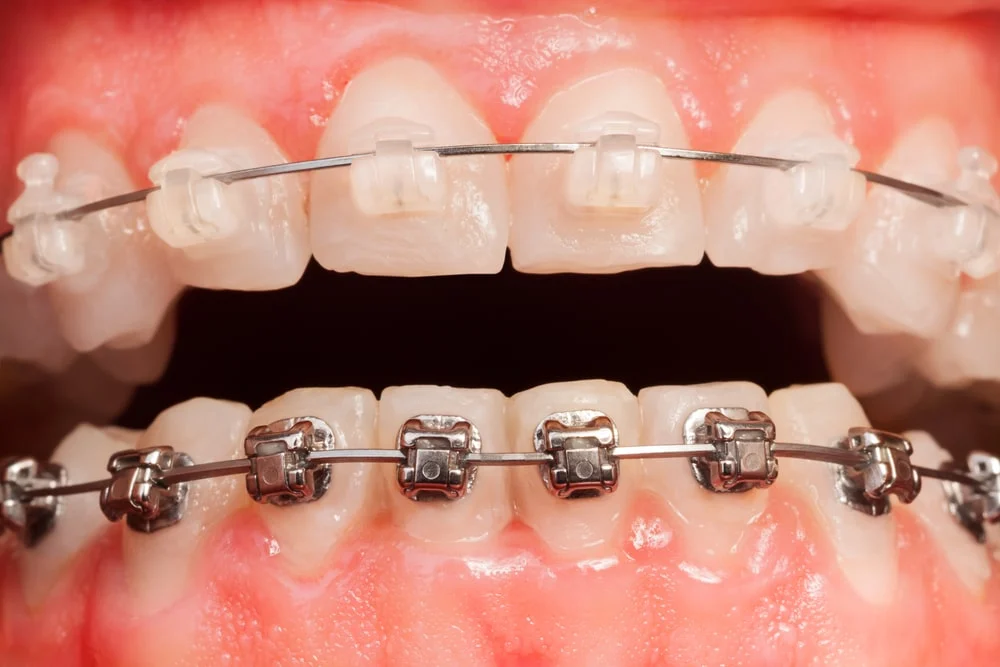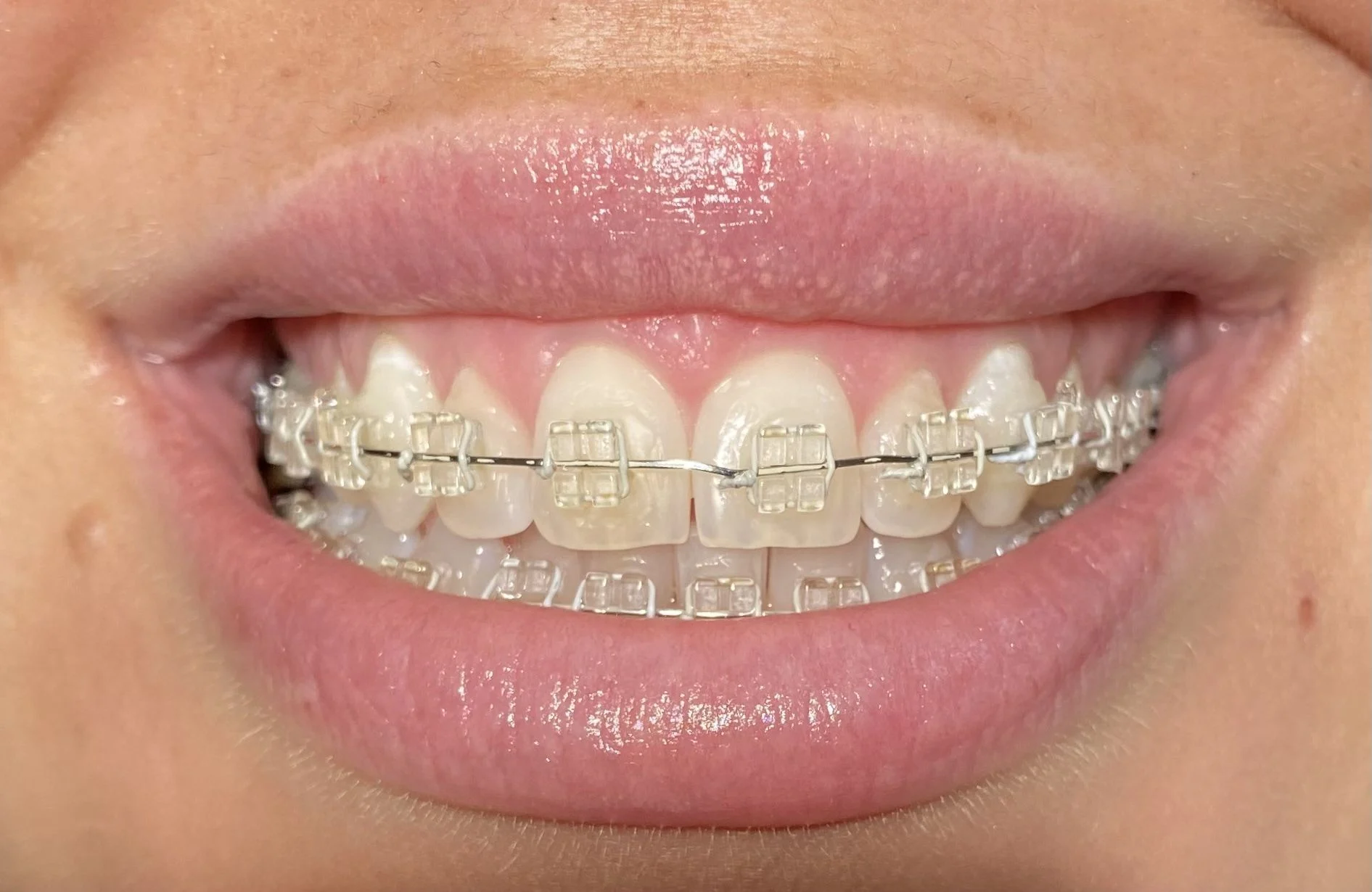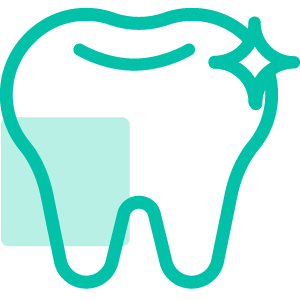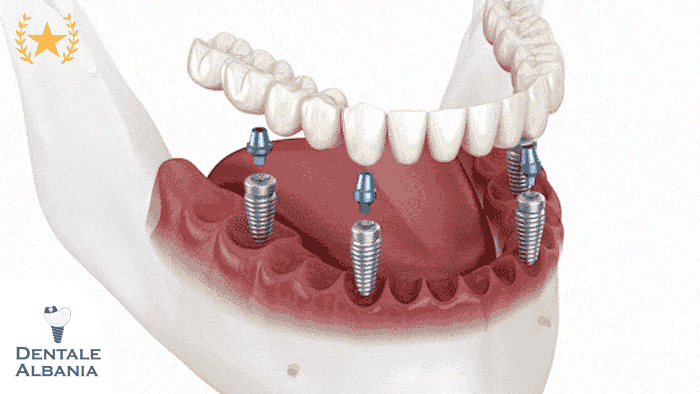What Are Fixed Braces and How Do They Work?

- Fixed braces are orthodontic devices that are permanently attached to the teeth during treatment, unlike removable aligners that patients can take out on their own.
- They consist of small brackets bonded to each tooth, connected by archwires that apply continuous, gentle pressure to guide the teeth into better alignment over time.
- The essential components include:
- Brackets: usually made of metal or ceramic, these are glued to the front (or sometimes back) of the teeth.
- Archwires: flexible wires that connect the brackets and control tooth movement.
- Bands: elastic or metal rings used to anchor brackets or molars in more complex cases.
- Ligatures: tiny rubber bands or clips that hold the archwire in place within the brackets.
- Over time, the pressure exerted by the archwire encourages the surrounding bone to reshape and accommodate the new position of each tooth. This process is called bone remodeling.
- One of the most important aspects of fixed braces is the need for regular adjustments by an orthodontist. Typically, these appointments occur every 4 to 8 weeks. During these visits, the orthodontist may tighten the wire, change elastics, or make other modifications to ensure continuous progress.
- Fixed braces are capable of correcting a wide range of issues — including overcrowding, misaligned bites, crooked teeth, and gaps — often with greater precision than removable systems.
- Despite their fixed nature, modern braces have become more refined, with options like self-ligating brackets, clear ceramic brackets, or even lingual braces that attach behind the teeth for a discreet look.
- Choosing fixed braces often means predictable, controlled, and effective results, especially for patients with moderate to severe orthodontic issues.
What Types of Fixed Braces Are Available Today?
Modern orthodontics offers a variety of fixed braces to suit different aesthetic preferences, treatment needs, and budgets. Understanding each type helps you make an informed decision about what might work best for your lifestyle and dental goals.
What Are Metal Braces and How Do They Function?
- Traditional metal braces are the most common type of fixed orthodontic appliance. Made from stainless steel, they are strong, durable, and highly effective for treating a wide range of dental misalignments.
- These braces involve brackets bonded to the front of each tooth and connected with metal archwires.
- Elastic bands or ligatures help secure the wire to the brackets. These come in various colors, allowing personalization.
- Metal braces are often the most affordable option and are suitable for both children and adults.
- Regular adjustments are needed to tighten the wires and maintain steady pressure on the teeth.
Are Ceramic Braces Less Visible Than Metal Braces?
- Ceramic braces, sometimes referred to as clear braces, function like metal braces but use tooth-colored or translucent brackets for a more discreet appearance.
- They are popular among adults seeking aesthetic alternatives to traditional metal braces.
- Although they are less visible, ceramic brackets are generally more fragile and can stain if not cleaned properly.
- Cost-wise, ceramic braces tend to be more expensive than metal braces but still offer a fixed and effective solution.
What Makes Lingual Braces Invisible?
- Lingual braces are fixed to the inner surface of the teeth, making them completely hidden from view.
- They provide the same corrective force as traditional braces but are custom-made for each patient’s anatomy.
- Lingual braces are often chosen by professionals or public-facing individuals who want the benefits of fixed braces without visible hardware.
- Not all patients are good candidates for lingual braces, especially those with severe bite issues or very small teeth.
What Is the Damon System and Why Is It Different?
- The Damon System is a type of self-ligating fixed braces that uses sliding mechanisms instead of elastic ties to hold the archwire in place.
- This design allows for reduced friction, leading to faster treatment times and fewer adjustment appointments.
- Damon braces are available in both metal and ceramic versions, combining efficiency with discretion.
- Many patients report greater comfort compared to traditional braces, and they’re also easier to keep clean due to the lack of elastics.
Who Can Benefit from Fixed Braces?
Fixed braces are one of the most versatile and widely used orthodontic solutions for correcting dental misalignments. Whether you’re a teenager or an adult, fixed braces offer predictable, long-lasting results across a wide range of orthodontic issues.
- Treatable Conditions: Fixed braces are highly effective at treating crowding, spacing, overbite, underbite, open bite, and crossbite. Because they apply continuous, controlled pressure on the teeth, they can realign even the most complex cases that removable aligners often struggle to correct.
- Crowding and Overlapping Teeth: When there isn’t enough space in the jaw for all the teeth to fit properly, fixed braces can slowly move each tooth into the right position, creating a more harmonious and functional bite.
- Misaligned Bites: Fixed braces are particularly useful in adjusting malocclusions (misaligned bites), such as when the upper teeth significantly overlap the lower teeth (overbite) or vice versa (underbite). These issues not only affect aesthetics but can also lead to chewing difficulties, jaw pain, and even speech problems if left untreated.
- Precision in Treatment: Fixed braces provide a level of precision and control unmatched by most removable systems. Orthodontists can make fine, frequent adjustments that guide the teeth into ideal alignment with predictable accuracy.
- Teenagers and Children: Traditionally, fixed braces have been most commonly used for adolescents, particularly those between the ages of 11 and 18. During this period, the jaw is still developing, and the teeth respond quickly to orthodontic pressure, making fixed braces a powerful tool for early correction.
- Adults: Contrary to common belief, fixed braces aren’t just for teens. More adults are opting for orthodontic treatment than ever before, and fixed braces remain a top choice for adult patients who need reliable and comprehensive corrections. With options like ceramic and lingual braces, adults can achieve discreet treatment with excellent outcomes.
Ultimately, anyone with permanent teeth and healthy gums can be a candidate for fixed braces, provided their oral health is stable. Prior to treatment, a full orthodontic assessment is required, including x-rays and impressions, to determine if fixed braces are the most appropriate solution.
Are Fixed Braces Suitable for Adults?

Fixed braces are not just for teenagers—many adults today are opting for orthodontic treatment to enhance both their appearance and oral health. The rise in adult orthodontics reflects a broader understanding that it’s never too late to improve your smile and correct dental issues.
- The Growing Trend in Adult Orthodontics: More adults are choosing fixed braces than ever before. Whether it’s to correct long-standing misalignments or to make cosmetic improvements, fixed braces provide a dependable solution. Advancements in orthodontic technology and aesthetics have removed many of the barriers that previously discouraged adults from seeking treatment.
- Treatment Complexity and Duration: One of the key differences between adult and adolescent orthodontic treatment is the bone density and reduced biological response in adults. This often means that tooth movement can take longer, and treatment plans might need to account for previous dental work like crowns, bridges, or implants. On average, adults wear fixed braces for 18 to 30 months, depending on the complexity of their case.
- Personalized Treatment Goals: Adults often pursue braces for specific, targeted reasons. Some may aim for full functional correction, especially if their bite affects speech or chewing. Others seek cosmetic improvements, such as straightening visible front teeth before a major event or career milestone.
- Aesthetic Options for Adults: Adult patients frequently express concern about the appearance of metal braces in professional or social settings. Fortunately, there are discreet fixed brace options that cater to these needs:
- Ceramic Braces: These use translucent or tooth-colored brackets to blend in with natural teeth, making them much less noticeable than traditional metal braces.
- Lingual Braces: Positioned on the inside of the teeth, lingual braces are completely hidden from view. They are custom-made and ideal for adults who want effective treatment without visible appliances.
- Commitment and Lifestyle Fit: Fixed braces require daily maintenance and regular orthodontic visits, but many adults find the investment worthwhile. With a clear understanding of the commitment, adults are often more compliant with treatment instructions, leading to highly successful outcomes.
In summary, fixed braces are an excellent choice for adults seeking long-term orthodontic correction. With the availability of less visible options and personalized plans, adult patients can undergo treatment confidently and discreetly.
How Long Do You Need to Wear Fixed Braces?
When considering fixed braces, one of the most common questions patients ask is how long the treatment will last. While the answer varies depending on individual cases, there are some general timelines and influencing factors that help set realistic expectations.
What Is the Average Treatment Duration?
- Most people wear fixed braces for a period ranging between 12 and 30 months.
- The average length of time depends on how severe the misalignment or bite issue is. Minor crowding may require only a year of treatment, while more complex cases can take over two years.
- Age can also play a role—younger patients often see quicker results because their jaws are still developing.
- The type of fixed braces used (such as traditional metal, ceramic, or Damon braces) may impact treatment speed. For example, self-ligating systems like Damon braces claim to reduce friction and result in faster alignment in some cases.
- Patient compliance—attending appointments regularly and following dietary and hygiene guidelines—can greatly influence how efficiently treatment progresses.
Can Braces Be Worn for a Shorter Time?
- In certain cases, yes. Accelerated orthodontics and limited treatment plans (targeting just front teeth) may shorten the duration to as little as 6 months.
- However, these are only appropriate for patients with minor misalignments or purely cosmetic concerns.
- Some practices offer adjunctive tools like vibratory devices or high-frequency pulsation tools that claim to stimulate faster tooth movement. While promising, their effectiveness is still being evaluated.
- It’s important to note that cutting corners on treatment duration may compromise the long-term stability of results. Rushing alignment without proper planning and retention often leads to relapse.
Can Teeth Move Back After Braces?
- Unfortunately, yes. Teeth have a natural tendency to shift back to their original position if not properly maintained after treatment.
- This is why wearing a retainer post-treatment is critical. Retainers can be removable or fixed, depending on the recommendation of your orthodontist.
- Most patients are advised to wear retainers full-time for a few months after braces, then switch to nighttime wear indefinitely.
- Skipping this step can lead to partial or complete relapse, undoing months or years of orthodontic work.
- Retainers also help stabilize the jawbone and soft tissues, allowing them to adapt to the new tooth position.
How Much Do Fixed Braces Cost?
Cost is a major consideration for anyone thinking about orthodontic treatment with fixed braces. While the investment can seem significant, understanding what influences the price and what financing options are available can make it much easier to plan. Let’s explore the key cost-related aspects.
What Is the Average Cost of Fixed Braces?
- The cost of fixed braces varies depending on the type of brace used—traditional metal braces are typically the most affordable, while ceramic and lingual braces come at a higher cost due to their discreet appearance and specialized manufacturing.
- On average:
- Metal braces range from €2,000 to €4,000
- Ceramic braces range from €3,000 to €5,000
- Lingual braces can cost between €5,000 and €8,000 due to the complexity of customization and placement
- Prices may also vary by location, with urban clinics or private orthodontic practices often charging more than regional or public providers.
- The complexity and duration of your treatment plan will affect the overall cost—more severe misalignment often requires longer treatment and more appointments, raising the price.
- Many orthodontic clinics offer initial consultations, sometimes for free, which can help assess the scope of treatment and offer a detailed price quote.
Can You Pay Monthly for Braces?
- Yes, most orthodontic clinics offer flexible financing options that allow patients to spread the cost of treatment over time.
- Common options include:
- Monthly instalment plans, sometimes interest-free over 12 to 24 months
- Third-party medical financing providers, which may offer longer repayment periods with low interest
- Discounts for paying upfront in full or for treating multiple family members
- These options make fixed braces accessible to more people, particularly adults seeking aesthetic or corrective treatment without having to pay everything at once.
What Makes Braces Expensive?
- Several factors contribute to the overall cost of fixed braces:
- Materials used: Ceramic and lingual braces use higher-cost materials and technology
- Specialist expertise: Orthodontists undergo additional years of training beyond general dentistry, and their time is priced accordingly
- Lab work: Custom brackets (especially for lingual braces) and specialized wires increase production costs
- Number of appointments: More complex cases require more frequent adjustments and follow-ups
- Retention phase: The post-treatment phase often includes retainers and monitoring visits, which are included in comprehensive pricing
- In some cases, insurance plans may cover part of the cost if the treatment is deemed medically necessary, especially for children and teens.
Are Fixed Braces Painful?
Orthodontic treatment with fixed braces inevitably involves a degree of discomfort. This is a natural part of the process, as your teeth are gradually moved into better alignment. However, the level and duration of pain can vary significantly from one person to another. Let’s break down what you can expect and how to manage it effectively.
How Painful Are Fixed Braces After Installation?
- After your fixed braces are first fitted, it’s common to experience soreness or tenderness in your teeth and gums. This usually begins a few hours after the appointment and can last three to five days.
- The pain results from the pressure applied by the brackets and wires, which stimulates bone remodeling as the teeth begin to shift.
- The discomfort is typically dull and aching rather than sharp or severe. It may be most noticeable when chewing, brushing your teeth, or waking up in the morning.
- You might also feel irritation on the inside of your cheeks or lips, especially where the brackets or wires rub against soft tissues. Using orthodontic wax can help minimize this.
- Over-the-counter painkillers like ibuprofen or paracetamol can provide effective relief during the first few days of adjustment.
- Eating soft foods (e.g., mashed potatoes, soups, smoothies) can reduce pressure on your teeth and make meals more manageable during the initial phase.
Can Braces Fail or Cause Side Effects?
- While fixed braces are highly effective, they’re not without potential risks or side effects.
- Bracket detachment is a common issue, especially if you eat hard or sticky foods. A loose bracket may delay your treatment if not repaired promptly.
- Wire irritation may occur when wires poke into the soft tissues of your mouth. This can lead to ulcers or sores but can usually be fixed quickly by your orthodontist.
- Tooth soreness after each adjustment is typical, as braces are tightened or repositioned to continue tooth movement. This discomfort is usually temporary.
- If oral hygiene is not maintained properly, braces can lead to plaque buildup, increasing the risk of tooth decay, decalcification (white spots), or gum inflammation.
- In rare cases, root resorption (shortening of the tooth roots) may occur during prolonged orthodontic treatment, though this is generally minimal and not harmful.
- Patients must follow their orthodontist’s instructions carefully—avoiding food restrictions, maintaining hygiene, and attending check-ups—to minimize complications.
What Can You Eat With Fixed Braces?

Eating with fixed braces involves some changes to your usual diet and habits. Since the brackets and wires can be delicate and food particles can get trapped easily, choosing the right foods—and avoiding the wrong ones—is essential to protect your braces and maintain oral hygiene throughout your treatment.
Are There Foods to Avoid With Braces?
- Fixed braces are vulnerable to breakage if exposed to hard or sticky foods. Foods like nuts, popcorn, hard candies, chewing gum, toffee, and crusty bread can easily damage brackets or dislodge wires.
- Sticky or chewy foods like caramels, licorice, or gummy sweets can get tangled in your braces and are difficult to clean, increasing the risk of tooth decay and plaque buildup.
- Hard fruits and vegetables such as apples and carrots should be cut into small pieces before eating to avoid excessive pressure on the brackets.
- Corn on the cob, ribs, and chicken wings should be removed from the bone and cut into manageable bites before consuming.
- Avoid biting into ice cubes or pens, as these habits can also damage your braces.
- Sugary foods and drinks should be limited as they increase the risk of demineralization around the brackets, leading to white spots and cavities.
Mention Alternatives That Are Safe and Comfortable to Eat
- Opt for soft foods that require minimal chewing and are less likely to damage your appliance. Great options include mashed potatoes, pasta, soft rice, scrambled eggs, yogurt, smoothies, and soups.
- Steamed vegetables are preferable over raw ones, as they are softer and less likely to stress the brackets.
- For snacks and sweets, pudding, soft cheese, and bananas are gentle on braces and satisfy cravings without risk.
- When craving something crunchy, thinly sliced apples or cucumber, or lightly toasted bread (with no seeds) may be safe when eaten carefully.
- Drinking plenty of water with meals can help wash away food particles and reduce plaque buildup.
How Do You Maintain Oral Hygiene With Braces?
- Brushing should be done after every meal using a soft-bristled toothbrush or electric toothbrush. Special orthodontic brushes are also available.
- Use fluoride toothpaste to protect enamel and avoid cavities during treatment.
- Interdental brushes and orthodontic floss threaders help clean around brackets and under the wires, areas that are otherwise hard to reach.
- Rinsing with fluoride mouthwash can further reduce the risk of cavities and support gum health.
- Regular dental check-ups and cleanings are crucial to monitor oral health during orthodontic treatment.
- Keeping a travel oral hygiene kit can help maintain cleanliness when eating outside your home.
Following these dietary guidelines not only protects your braces from damage but also contributes significantly to a successful and timely orthodontic outcome. Adapting your food choices and cleaning routine will help you get the most out of your treatment.Do Braces Change Your Face or Jawline? (H2)
Many patients wonder if fixed braces can influence more than just their teeth alignment—specifically, whether they can alter the overall appearance of their face or jawline. The short answer is yes, braces can cause subtle facial changes, especially when they correct significant orthodontic issues. However, these changes are typically positive and improve symmetry and balance.
Explain How Orthodontics Can Affect Facial Aesthetics
- Fixed braces can significantly enhance facial aesthetics by correcting underlying issues like overbites, underbites, crossbites, and open bites.
- An overbite correction may reduce a protruding upper lip or receding chin, creating a more balanced facial profile.
- Braces that address jaw misalignment can help reposition the mandible (lower jaw), making the jawline appear more defined.
- Correction of crooked or crowded teeth also influences how your lips rest when your mouth is closed, contributing to a more relaxed and aesthetically pleasing look.
- In cases of severe bite problems, facial asymmetry caused by misaligned jaws may also be improved.
- Braces do not change bone structure in adults, but they can influence soft tissue positioning, which may lead to visible differences in facial shape or expression.
Clarify Common Myths About Braces Changing Lip Shape or Voice
- Some people worry that braces will make their lips bigger or smaller. In reality, any lip changes are usually due to the underlying shift in tooth and jaw positions and are minimal.
- When protruding teeth are pushed back, the lips may appear slightly less prominent, but this is part of a more harmonious facial transformation.
- Braces do not affect voice tone or speech permanently. While there may be a brief period of adjustment—especially with lingual braces—the tongue quickly adapts, and normal speech returns.
- In most cases, patients find that any changes to lips or speech are temporary and minor, while the benefits of improved bite and appearance far outweigh these concerns.
Discuss Long-Term Facial Symmetry Improvements
- By aligning the teeth and correcting jaw discrepancies, braces can significantly improve facial symmetry, especially when orthodontic problems are addressed at a young age.
- Long-term improvements are most notable in growing adolescents, as their facial bones are still developing and adapt better to orthodontic guidance.
- Adults can also experience facial improvements, although the changes are generally less dramatic and focused on dental symmetry and soft tissue balance.
- Orthodontic treatment can enhance self-esteem and confidence, as patients often report a more attractive, youthful appearance after braces.
Fixed braces do more than straighten teeth—they can positively impact facial structure, leading to a more balanced and harmonious appearance. These benefits, both functional and aesthetic, are key reasons why many adults and teens opt for fixed orthodontic solutions.
Which Braces Work Faster and Why?
Speed is often a deciding factor when choosing an orthodontic treatment. Patients frequently ask which braces deliver the fastest results while maintaining quality and safety. The answer depends on individual needs, the complexity of the dental issues, and the specific technology used in the braces.
Compare Fixed and Removable Braces in Terms of Treatment Speed
- Fixed braces, particularly traditional metal braces, generally work faster than removable options like clear aligners when treating moderate to severe orthodontic cases.
- This is because fixed appliances exert continuous, controlled pressure on teeth, which leads to consistent movement.
- Removable aligners like Invisalign may be slower if not worn for the required 22 hours a day, and compliance plays a big role in their effectiveness.
- For complex issues such as significant crowding, deep bites, or crossbites, fixed braces are more predictable and often result in shorter treatment times.
- However, for minor corrections, clear aligners may be quicker due to their targeted design and shorter treatment cycles, sometimes using systems like Invisalign Lite.
Explain How Self-Ligating Systems Reduce Treatment Time
- Self-ligating braces, like the Damon System, use a slide mechanism instead of elastic bands to hold the wire in place.
- This technology reduces friction between the brackets and the wire, allowing teeth to move more freely and efficiently.
- With less resistance, lighter forces are applied, resulting in faster tooth movement and potentially shorter treatment durations.
- Patients using self-ligating braces often require fewer adjustment appointments, which is both convenient and time-saving.
- Because they exert continuous and gentle pressure, these systems can also accelerate the alignment phase, especially in cases involving crowding or spacing.
- Some studies suggest treatment with Damon braces can be up to six months faster than with conventional metal braces.
Discuss Case Complexity and How It Influences Treatment Speed
- The more complex the case, the longer the treatment will typically take. Severe bite problems, jaw misalignments, or teeth that require significant rotation demand more time.
- Treatment speed is also influenced by bone density, age, and biological response—factors that vary from patient to patient.
- Teens tend to respond faster to orthodontic treatment due to active bone growth, while adult cases may take slightly longer.
- Early diagnosis and timely intervention with the right type of braces can significantly reduce overall treatment time.
- Orthodontists often personalize the treatment plan based on individual anatomy, dental history, and goals, choosing the fastest and most efficient system that will still ensure safe and stable results.
In conclusion, while traditional metal braces are generally the fastest for complex corrections, self-ligating systems like Damon can further accelerate the process with less discomfort. Removable aligners may be quicker for minor cosmetic cases, but consistent wear is essential.
What Are the Main Differences Between Fixed and Removable Braces?
Choosing between fixed and removable braces is a crucial decision in orthodontic treatment. Each type comes with its own set of advantages and disadvantages, making it essential to understand their differences based on your lifestyle, dental needs, and treatment goals.
Compare Visibility, Removability, Maintenance, and Cost
- Visibility: Fixed braces, especially metal ones, are more visible as they consist of metal brackets and wires. Ceramic braces offer a more discreet appearance but are still noticeable. Removable options like clear aligners (e.g., Invisalign) are nearly invisible and often preferred by adults seeking subtle treatment.
- Removability: Fixed braces stay in place 24/7 and can only be removed by an orthodontist. In contrast, removable braces like aligners can be taken out while eating, brushing, or for special occasions—offering greater flexibility but also requiring discipline to wear them for at least 22 hours daily.
- Maintenance: Fixed braces require careful cleaning, as food can get trapped in brackets and wires. Patients must use specialized tools like interdental brushes or water flossers. Removable braces simplify oral hygiene routines since they can be removed during brushing and flossing.
- Cost: Removable braces typically cost more, especially if using premium brands like Invisalign. Fixed metal braces are often more affordable, while ceramic and lingual braces come at a higher price due to materials and customization.
Highlight Pros and Cons for Different Lifestyles or Age Groups
- Teens and children: Fixed braces are ideal for younger patients as they don’t depend on the user for compliance. They are durable, effective, and suitable for most orthodontic issues.
- Adults: Removable aligners are popular among adults who value aesthetics and flexibility. However, fixed ceramic or lingual braces may also appeal due to their discreet appearance.
- Active individuals: Those engaged in sports may benefit from removable aligners to avoid mouth injuries, though fixed braces can be paired with protective mouthguards.
- Busy lifestyles: Fixed braces work continuously without needing patient involvement, making them convenient for those less likely to adhere to strict aligner wear schedules.
Explain When Dentists Recommend One Over the Other
- Complex orthodontic problems: Dentists usually recommend fixed braces for correcting severe misalignments, bite issues, or teeth rotation, as they provide precise control.
- Mild to moderate cosmetic adjustments: Removable aligners are suitable for minor crowding or spacing problems, provided the patient can commit to wearing them as prescribed.
- Patient preference and lifestyle: Orthodontists assess the patient’s habits, discipline, and aesthetic expectations when recommending a type of brace. Some might prioritize discreetness, while others focus on speed and strength.
Ultimately, the choice between fixed and removable braces depends on individual needs, case complexity, and how committed the patient is to following the treatment plan. Your orthodontist will guide you to the most suitable option after a comprehensive consultation.
How Do Fixed Braces Move Teeth Precisely?

Orthodontic treatment with fixed braces is a highly controlled process that gradually moves your teeth into better alignment. But how does this complex transformation actually occur? Understanding the biological mechanics and engineered design of braces helps patients appreciate the precision behind their treatment.
Describe Biological Processes: Bone Remodeling and Ligament Tension
- Bone Remodeling: Fixed braces initiate tooth movement through a biological process called bone remodeling. As gentle pressure is applied by the braces, the periodontal ligament (a tiny cushion between the tooth and bone) responds by signaling bone cells.
- Osteoclasts and Osteoblasts: On the side where the tooth is being pushed, osteoclasts break down bone, creating space. Simultaneously, on the opposite side, osteoblasts build new bone to stabilize the tooth in its new position.
- Controlled and Gradual Movement: Because bone remodeling takes time, this process is slow and deliberate—ensuring the teeth move without causing damage to the roots or surrounding structures.
- Inflammatory Response: Initially, patients may experience soreness or tenderness, which is a sign that the body is responding to the mechanical forces applied.
Explain Role of Wires and Brackets in Controlled Tooth Movement
- Brackets: Each bracket is custom-positioned on a tooth to act as a handle, allowing the orthodontist to apply targeted forces. Brackets can be made of metal or ceramic and are bonded directly onto the teeth.
- Archwires: The archwire connects all the brackets and acts as the engine behind tooth movement. It is often made of shape-memory alloys like nickel-titanium, which return to their original form—creating constant pressure as they try to regain their shape.
- Ligatures or Clips: In conventional braces, small elastic ligatures secure the wire to each bracket. In self-ligating systems like Damon braces, sliding mechanisms reduce friction and allow the wire to move more freely.
- Sequential Adjustments: The orthodontist periodically replaces or adjusts the wires to maintain the force needed for continuous movement, guiding teeth into their desired positions over time.
Precision Customization Based on Individual Needs
- Every patient’s anatomy is unique, so orthodontists create a detailed treatment plan using X-rays, digital scans, and bite impressions.
- Modern technology allows orthodontists to predict the path each tooth will follow and program braces accordingly.
- In complex cases, elastics or auxiliary appliances may be added to guide jaw growth or correct bite discrepancies.
Fixed braces aren’t just about applying pressure; they’re about engineering that pressure with scientific precision to harness your body’s own biological processes. This combination of biomechanics and modern dental technology ensures long-term results and lasting oral health improvements.
Frequently Asked Questions About Fixed Braces
Patients often have lingering questions before starting their orthodontic journey. Here are answers to two of the most frequently asked questions about fixed braces, covering key concerns around duration and cost-effectiveness.
How Long Do Fixed Braces Stay On?
- Typical Duration Range: The average treatment time for fixed braces is between 12 to 30 months. The exact duration depends on the complexity of the dental issues being addressed, such as crowding, gaps, overbites, underbites, or crossbites.
- Mild vs. Severe Cases: Simple alignment corrections may be completed in under a year, while more severe malocclusions or jaw issues can extend treatment to over two years.
- Growth and Age Factors: Teenagers often experience faster results due to ongoing jaw development, while adults may require more time since their facial structure has finished growing.
- Consistency Matters: Keeping up with regular appointments and following your orthodontist’s guidance—such as using elastics properly—can help keep treatment on track.
- Missed Appointments or Breakages: Skipping visits, breaking brackets, or not following instructions can significantly delay progress, prolonging the duration braces must be worn.
- Post-Braces Retention Phase: Even after the braces are removed, a retainer is typically worn (sometimes full-time initially, then at night) to prevent the teeth from shifting back, which is known as orthodontic relapse.
Which Braces Are the Cheapest?
- Fixed Metal Braces: These are generally the most affordable type of fixed orthodontic treatment. They use stainless steel brackets and wires and are highly effective for a wide range of dental issues.
- Ceramic Braces: These cost more than metal braces due to their aesthetic appeal and less visible appearance, but they are still less expensive than lingual or Invisalign options.
- Lingual Braces: Custom-designed to fit behind the teeth, lingual braces are usually the most expensive option due to the complexity of placement and adjustment.
- Self-Ligating Systems (e.g., Damon Braces): While slightly more expensive than traditional metal braces, they may offer cost savings in the long term due to fewer visits and potentially shorter treatment times.
- Insurance and Financing: Many orthodontists offer flexible monthly payment plans, and some dental insurance plans cover part of the cost—especially for patients under 18.









